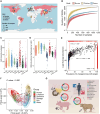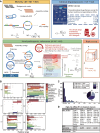Global health risks lurking in livestock resistome
- PMID: 40577477
- PMCID: PMC12204175
- DOI: 10.1126/sciadv.adt8073
Global health risks lurking in livestock resistome
Abstract
Livestock farming consumes more than 70% of global antibiotics annually, making livestock manures an important vector of anthropogenically influenced antibiotic resistance genes (ARGs). The global pattern of the livestock resistome, its driving mechanisms, and transmission potential to the clinic are not well assessed. We analyzed 4017 livestock manure metagenomes from 26 countries and constructed a comprehensive catalog of livestock ARGs and metagenome-assembled genomes. Livestock resistome is a substantial reservoir of known (2291 subtypes) and latent ARGs (3166 subtypes) and is highly connectable to human resistomes. We depicted the global pattern of livestock resistome and prevalence of clinically critical ARGs, highlighting the role of farm and human antibiotic stewardship in shaping livestock resistome. We developed a risk-assessment framework by integrating mobility potential, clinical significance, and host pathogenic relevance, and prioritized higher risk livestock ARGs, producing a predictive global map of livestock resistome risks that can help guide research and policy.
Figures






Similar articles
-
The risk of pathogenicity and antibiotic resistance in deep-sea cold seep microorganisms.mSystems. 2025 Jun 17;10(6):e0157124. doi: 10.1128/msystems.01571-24. Epub 2025 May 21. mSystems. 2025. PMID: 40396743 Free PMC article.
-
Dissecting the gut microbial communities and resistomes of wild rats from different ecological areas in Hong Kong.Environ Res. 2025 Oct 15;283:122108. doi: 10.1016/j.envres.2025.122108. Epub 2025 Jun 10. Environ Res. 2025. PMID: 40499635
-
Antibiotic resistome in the glacier forelands of polar regions.Appl Environ Microbiol. 2025 Jun 18;91(6):e0076225. doi: 10.1128/aem.00762-25. Epub 2025 May 16. Appl Environ Microbiol. 2025. PMID: 40377330 Free PMC article.
-
The neonatal intestinal resistome and factors that influence it-a systematic review.Clin Microbiol Infect. 2022 Dec;28(12):1539-1546. doi: 10.1016/j.cmi.2022.07.014. Epub 2022 Jul 19. Clin Microbiol Infect. 2022. PMID: 35868586
-
Effect of ozonation-based disinfection methods on the removal of antibiotic resistant bacteria and resistance genes (ARB/ARGs) in water and wastewater treatment: a systematic review.Sci Total Environ. 2022 Mar 10;811:151404. doi: 10.1016/j.scitotenv.2021.151404. Epub 2021 Nov 9. Sci Total Environ. 2022. PMID: 34767893
References
-
- Van Boeckel T. P., Pires J., Silvester R., Zhao C., Song J., Criscuolo N. G., Gilbert M., Bonhoeffer S., Laxminarayan R., Global trends in antimicrobial resistance in animals in low- and middle-income countries. Science 365, eaaw1944 (2019). - PubMed
MeSH terms
Substances
LinkOut - more resources
Full Text Sources
Medical

